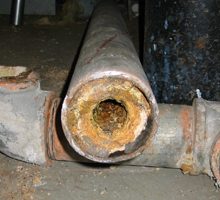TDT Plumbing restores hot water system at Avenue Plaza Resort
By Amanda Strouse

With the integration and increasing popularity of innovative technologies in the plumbing marketplace, it may be harder and harder to åonvince commercial and multi-family clients that a repipe is the best solution to repair failing or aged pipes.
Why would a commercial skyscraper, a hotel, or more importantly, a hospital, pay a contractor to permissibly close down a section of the building so that floors could be dug up, walls could be torn out, bathrooms could be closed and business could suffer, when there is another option available to prevent those massive expenses and inconveniences?
With cost-effective and green alternatives readily available by thousands of plumbing companies across the United States, one would figure that the client who chooses a repipe over the fleet of other options is an ignorant client, at best. Don’t be a plumbing company that doesn’t keep up with the latest technological trends.
The safest, most effective repipe alternative is epoxy coating technology — also known as pipe lining or relining. Epoxy pipe lining is an in-situ process that introduces epoxy resin into pipes and then allows the epoxy to cure, forming a protective liner that acts as the new host pipe or protective barrier coating that is adhered to the host pipe. This liner is created or installed by using existing access points to push, pull or blow the epoxy liner into place. It serves as a long-term repair method for all types of aging or failing pipe systems. No destruction is necessary to utilize pipe lining technology, unless the system does not have available access points, and they must be created (for an example, this might be the case for a century-old sanitary main located underground).
There are various manufacturers of pipe lining technologies, with each technology having different benefits. For instance, the ePIPE epoxy coating technology, which is developed and manufactured by ACE DuraFlo, and installed by certified ACE DuraFlo licensees and franchisees, is the fastest curing epoxy approved for small diameter pipe restoration.
For buildings undergoing current renovations, pipe lining makes it easy to restore an old or failing pipe system while having other contractors work on the property. It also prevents the need to undergo asbestos abatement, which is a huge benefit. And most importantly, it allows the client to continue business.
In addition, pipe lining restoration improves the pipe system by increasing its efficiency. Within larger buildings, where a mechanical room is the heart of the plumbing and mechanical piping systems, pipe lining restoration greatly increases efficiency within the mechanical room. After the pipes are cleaned of corrosion and debris and then coated, the pipe system does not have to work as hard, thereby saving maintenance costs, water costs and electricity costs.
For instance, ePIPE technology was used to restore the 54-year-old hot water system in the lavish Avenue Plaza Resort in New Orleans, Louisiana. The failing pipes were discovered during a major renovation, and they had to be repaired quickly, with as little disruption to the other contractors and their projects as possible. To make matters more complicated, the building had asbestos and abatement was not feasible. TDT Plumbing, the contractor on the project and one of the central U.S.’s largest and most experienced pipe restoration teams, was chosen to perform the in-place pipe restoration project for the 23-story vacation resort.
After a thorough inspection of the copper and galvanized hot water system, the TDT Plumbing technicians identified extreme calcium buildup throughout the entire system — a common problem found in areas with hard water. Some lines were found to be 100 percent blocked with calcium. These large calcium deposits and blockages caused the pipe system to experience low water flow, variable water temperatures and variable water pressure.
The TDT Plumbing crew knew that the ePIPE technology was the ideal solution for the hotel. The ePIPE technology uses existing access points to push clean, compressed air through the pipes for the cleaning and lining processes. First, an abrasive agent is blown through the pipes to thoroughly clean and prepare them for the resin. Once that process is completed, then the epoxy resin is blown through the pipe system.
Mathematical calculations are done prior to ensure that enough epoxy is used to effectively coat all of the pipes. Once the epoxy cures, it forms a protective barrier coating within the pipes that greatly extends the useful life of the pipe system and brings it to a better-than-new state. This epoxy coating will reduce the opportunity for calcium buildup in the future, as well as corrosion, pinhole leaks and other problems. There were a total of 28 hot water risers and branch lines rehabilitated, from the re-circulation loop to the main hot water supply line on the 12th floor.




